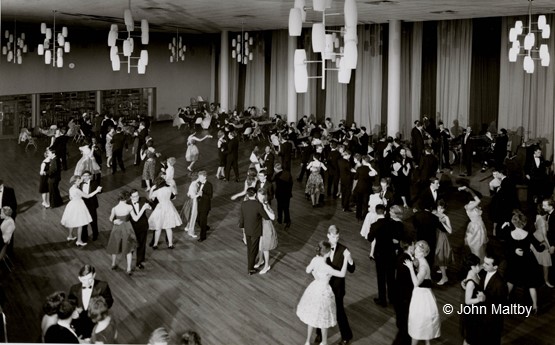Fulton House, which was called College House from when it first opened in 1961 until 1986, is one of the most historically significant buildings on the Singleton Campus. Throughout the early 1950s, extensive plans were put in place to expand the Singleton site. At the core of this vision was a large building that could act as a meeting place, and a social and academic hub. This is what it became after 1961. The building contained common rooms, a music room, a coffee lounge, an extra library, a book shop and a barber’s shop. This had a profound impact on the kind of community that was able to flourish at the University. Until 1961, staff and students had to use the University on a broadly ‘nine-to-five’ basis, and whilst there was a refectory and senior common room, there was no major on-campus meeting place.
College House changed all that. In the process, it also became the venue for large music concerts. From the early 1960s, the University had its own band called the Bogies, who were very popular. Students would queue to watch them play at the University. Bigger names came to play as well, including The Who in around 1965. Prys Morgan, who was a young lecturer at the time, was charged with meeting the band and showing them to the room where they could prepare for the gig. He, like many people at the time, had not heard of them before and remembers how they were very late because they had got seriously lost on the journey to Swansea, deciding to drive through the windy roads of mid-Wales and the Valleys!
The Who in an early publicity shot. (L to R – John Entwistle, Roger Daltrey, Pete Townshend and Keith Moon). 1965/66. KRLA Beat. Wiki Commons.

The building of College House, where bands like the Who played, coincided with the erection of two on-campus halls of residence towers. This meant that many students from the early 1960s could live their entire lives on campus had the wanted to, taking their meals and breaks in College House and even having formal dinners in the dining rooms, where, for the first couple of decades at least, students wore gowns and sat in rows at long tables. The practice was deliberately designed to mirror elite university behaviour. College House was designed by the architects Percy Thomas and Sons, and especially their associate Dale Owen. Its appearance is very deliberate. It has big windows overlooking Singleton Park and Swansea Bay.
The material is courtesy of the Richard Burton Archives, Swansea University.

Students dancing in College House, c.1960s. © John Maltby
Prys Morgan describes The Who's challenging journey to get to Swansea for a gig in the 1960s. (Professor Prys Morgan interviewed by Dr Sam Blaxland, Voices of Swansea University, 1920-2020. 2017)
